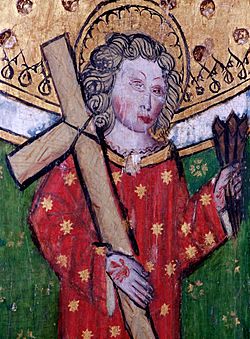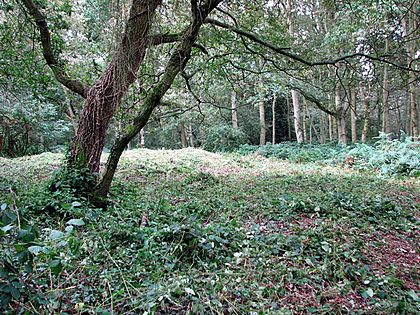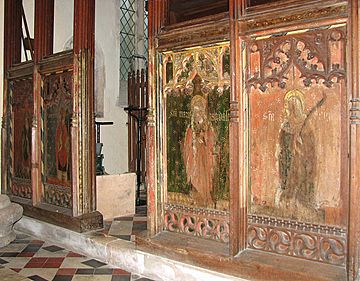William of Norwich facts for kids
Quick facts for kids Saint William(cult suppressed) |
|
|---|---|

Painting at the church of St Peter and St Paul, Eye, Suffolk, c. 1500
|
|
| Holy Martyr | |
| Born | 2 February 1132 Norwich, England |
| Died | c. 22 March 1144 (aged 12) Norwich, England |
| Venerated in | Folk Catholicism |
| Canonized | Never officially canonised. |
| Feast | 26 March (removed from the Universal Calendar) |
| Attributes | Depicted holding nails, with nail wounds or undergoing crucifixion |
|
Catholic cult suppressed
|
After the Congregation |
William of Norwich (born February 2, 1132 – died around March 22, 1144) was an English boy. After he disappeared and was found dead, people at the time wrongly blamed the Jewish community in Norwich. This event was the first known time in the medieval period that Jews were accused of "ritual murder."
A "blood libel" is a false accusation. It claims that Jewish people kill Christians, especially children, for religious rituals. These accusations often happened when religious centers were trying to attract more visitors and donations. The monks in Norwich, who promoted William as a saint, did not have a popular local saint. Some people believe they used these accusations to benefit their monastery.
William was learning to be a tanner, someone who prepares animal hides. He often met with Jewish people as part of his work. His death is still a mystery today. Even though the local community blamed the Jews, the authorities did not find them guilty because there was no proof. William was later seen as a folk saint in Norwich, and some people claimed he performed miracles.
William's story was written down by Thomas of Monmouth. He was a monk at the Norwich Benedictine monastery. His book, The Life and Miracles of St William of Norwich, was written in Latin. Monmouth started writing around 1149, years after William's death. He likely wanted to make William's story popular again.
William's Story: What Happened?
Most of what we know about William comes from Thomas of Monmouth's book. It is hard to tell the real facts from the story of him becoming a saint.
The Anglo-Saxon Chronicle's Account
The Anglo-Saxon Chronicle also mentions William's death. It places the event around 1137, which is earlier than Monmouth's account. The Chronicle says:
- "In his reign the Jews of Norwich bought a Christian child before Easter."
- "They tortured him like our Lord was tortured."
- "On Long-Friday, they hanged him on a cross, making fun of our Lord."
- "Afterwards, they buried him."
- "They thought it would be hidden, but our Lord showed he was a holy martyr."
- "The monks took him and buried him with great honor in the minster."
- "Through our Lord, he performs wonderful miracles, and is called St. William."
Thomas of Monmouth's Investigation
Thomas of Monmouth arrived in Norwich around 1150. The Bishop asked him to look into William's death. Monmouth interviewed people who were still alive and remembered the events. He also spoke to people he called "converted Jews." He claimed they gave him secret information about the Jewish community. He wrote his detailed story in his book, The Life and Miracles of St William of Norwich.
William's Life and Disappearance
According to Monmouth, William was born on February 2, 1132. His parents were local people. William became an apprentice to a skinner and tanner. This meant he often worked with local Jewish people. Monmouth suggested that William's skill or the Jews' "greed" led to these work connections.
Monmouth wrote that a man approached William's mother. This man claimed to be a cook for the Archdeacon of Norwich. He offered William a job in the Archdeacon's kitchens. William's mother was paid three shillings to let her son go. William then visited his aunt with this man. His aunt was suspicious. She asked her daughter to follow them. They were last seen entering a local Jew's house. This was on Holy Tuesday, and it was the last time William was seen alive.
The False Accusation of Ritual Murder
Monmouth described William's death in great detail. He claimed it was a ritual torture and murder, like the crucifixion of Jesus. Monmouth wrote that William's head was shaved. Then, it was stabbed with many thorn points. Blood flowed horribly from the wounds. Some people present, he claimed, decided to nail him to a cross. This was supposedly to mock Jesus's suffering. William's body was later found in Thorpe Wood. It had a crown of thorns on its head.
Monmouth also claimed William was crucified "in mockery of the Lord's passion." He also said William had a terrible wound on his left side. This was similar to the wound described in the Bible about Jesus's death.
Discovery of the Body
According to Monmouth, William's body was found on Holy Saturday. It was in Mousehold Heath, which was part of Thorpe Wood, outside Norwich. A local nun saw the body first but did not tell anyone right away. Then, a forester named Henry de Sprowston found it. He noticed injuries that showed a violent death. The boy also seemed to have been gagged with a wooden teasel. William was wearing a jacket and shoes.
After talking with the parish priest, they decided to bury the body on Easter Monday. Many local people came to see it. William was recognized. The body was buried at the spot where it was found. The next day, William's family arrived. One of them was a priest, Godwin Stuart. They confirmed William's identity. They dug up the body and then reburied it with a proper ceremony.
The Investigation and Protection of Jews
William's family and other English people quickly blamed the local Jewish community. They demanded justice from the church court of Bishop William de Turbeville. The Bishop asked members of the Jewish community to come to court. He wanted them to go through a trial by ordeal. However, the local Norman sheriff, John de Chesney, told them the church court had no power over them. This was because they were not Christians.
The sheriff then took the Jews to Norwich Castle for their safety. Once things calmed down, they returned home. The issue came up again two years later. This was when a Jewish person was killed in a separate event. King Stephen agreed to look into the matter. But he later decided not to pursue it.
Meanwhile, William's body was moved to the monks' cemetery. Bishop de Turbeville and other church leaders tried to create a special devotion, or cultus, around him as a Christian martyr. But this plan did not fully succeed. At first, there was no proof that the murder was religious. But as the cult grew, so did the story of why William was killed.
The Theobald of Cambridge Story
Thomas of Monmouth said his account came from a monk named Theobald of Cambridge. Theobald was a former Jew. He claimed William's murder was a human sacrifice. He said that "ancient writings of his fathers" required killing a Christian every year. This was supposedly to help them return to the Holy Land during the Messianic Age. It was also, he claimed, to punish Jesus Christ for the persecution Jewish people faced. However, there is no such command for human sacrifice in Jewish theology or religious books.
Theobald also claimed the murderers were not practicing Orthodox Judaism. He said the murder was ordered in Narbonne. A cult leader there had claimed to be the Jewish Messiah. This leader supposedly cast lots to choose where in Europe his followers would commit the murder.
Monmouth supported this claim. He said a Christian servant woman saw the child through a crack in a door. Another man, years later, confessed on his deathbed. He claimed he saw a group of Jews moving a body on a horse in the woods.
Historical Background
The Jewish Community in Norwich
The Jewish community in Norwich likely started around 1135. This was only nine years before William's death. (However, one Jew named 'Isaac' is mentioned in the Domesday Book of 1086). Most Jewish people lived in a Jewish quarter, or "Jewry." This area is now Haymarket and White Lion Street. The Jews spoke French, like the recently settled Anglo-Normans. They were closely connected to the Normans. The "Jewry" was very close to Norwich Castle. This pattern was seen in other English towns. Jews were often under the protection of the Normans.
William and his family were of Anglo-Saxon background. Several of his relatives were married priests, following local traditions. There were often conflicts between local Anglo-Saxons and Normans. This might have led to conspiracy theories. People might have thought that French-speaking Jews committed crimes. And that French-speaking Normans covered them up. Tensions were very high during King Stephen's rule, when the murder happened. Thomas of Monmouth claimed the sheriff was bribed by the Norwich Jewish community to protect them.
There might also have been disagreements between the cathedral, the sheriff, and local people. These were about rights in the city. Monmouth often said that God was the only source of justice for Anglo-Saxons. He claimed God would punish corrupt Norman sheriffs. He also said that John de Chesney, the sheriff who protected the Jews, later suffered from internal bleeding as punishment.
The Cult of Saint William

The local church leaders, especially Bishop William de Turbeville, wanted to create a special devotion to William. This might have been partly for money. The Bishop encouraged Thomas of Monmouth to interview people and write his book.
After being buried in the monks' cemetery, William's body was moved to more important places in the church. It was placed in the chapter house in 1150. In 1151, it was moved close to the High Altar. Monmouth's book mostly focuses on proof of William's holiness. He wrote about mysterious lights seen around the body. He also wrote about miraculous cures for local people who prayed to William. Monmouth admitted that some clergy, like Prior Elias, were against the cult. They felt there was little proof of William's true devotion or martyrdom. Monmouth promoted the claims by sharing stories of visions of William and miracles.
Historian Paul Dalton says that the cult of William was mostly "protective and peaceful." It was similar to the cult of another child saint, Faith of Conques. Despite its beginnings, the cult itself did not promote anti-Jewish actions. Even at its most popular, it was a small cult. There is not much evidence of a very popular cult of William in Norwich. Records of money offered at his shrine at Norwich Cathedral show that few pilgrims visited. However, offerings continued until at least 1521. The shrine's popularity grew for a short time after 1376. This was when William was adopted by the Norwich Peltier's Guild. Their yearly service at the Cathedral included a child playing William. There was also a scholars' guild dedicated to St William in Bishop's Lynn, Norfolk.
Pictures of William as a martyr were made for some churches. These were usually near Norwich. A painted oak panel showing William and Agatha of Sicily is in the Victoria and Albert Museum in London. William is shown holding a hammer. He has three nails in his head. This panel was once part of a rood screen at the Norwich Church of St John Maddermarket. A merchant named Ralph Segrym (died 1472) ordered the screen. He became a Member of Parliament and Mayor of Norwich.
William is also shown on the rood screens of other Norfolk churches. These include St Mary's Church, Worstead, and St John's Church, Garboldisham. In these, William is holding nails. The screen in Holy Trinity Church, Loddon, shows William being crucified.
What Happened Next?
The story of William's supposed ritual murder caused strong feelings. The authorities protected the accused Jewish people. This made people more suspicious of corrupt sheriffs and nobles working with Jews. This added to the general anti-Jewish and anti-Norman mood. After Thomas of Monmouth's story spread, other unsolved child deaths were also blamed on Jewish conspiracies. These included Harold of Gloucester (died 1168) and Robert of Bury (died 1181). The most famous was Little Saint Hugh of Lincoln (died 1255). This pattern of false accusations became known as the blood libel.
By the time Richard the Lionheart was king, attitudes towards English Jews were less accepting. This, along with growing support for a Crusade, led to attacks. In 1189, a group of Jewish representatives attended Richard's coronation. They were attacked by the crowd. A widespread attack on the Jewish population began. This led to massacres of Jews in London and York.
More attacks followed across England. In Norwich, the Norman nobles tried to stop these actions. But the local farmers and peasants rebelled against the lords. They attacked their supporters, especially Norwich's Jewish community. On February 6, 1190, Jews found in their homes in Norwich were killed. Others had found safety in Norwich Castle.
In 2004, during building work in Chapelfield, Norwich, a well was found. It contained the remains of at least 6 adults and 11 children. Studies showed strong links to living Ashkenazi Jewish groups.
Hostility against Jews continued. In 1290, King Edward I expelled Jews from England. Jews were not officially allowed to live in England again until after 1655. This was when Lord Protector Oliver Cromwell asked for the Whitehall Conference. It debated ideas from Menasseh ben Israel. Although the Conference did not make a final decision, it marked the start of Jewish people returning to England.
See also
- Andreas Oxner
- Blood libel
- Little Saint Hugh of Lincoln
- Simon of Trent
- The Prioress's Tale
- Werner of Oberwesel
 In Spanish: Guillermo de Norwich para niños
In Spanish: Guillermo de Norwich para niños


